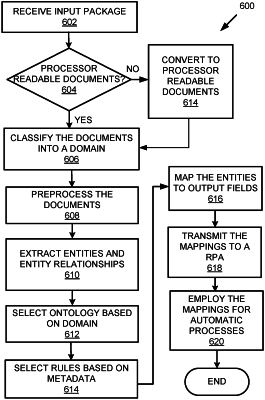| CPC G06N 20/00 (2019.01) [G06F 16/285 (2019.01); G06F 16/93 (2019.01)] | 20 Claims |

|
1. A machine learning (ML) based data transformation system comprising:
at least one processor;
a non-transitory processor readable medium storing machine-readable instructions that cause the at least one processor to:
receive an input package including a plurality of documents and related metadata for mapping;
categorize the plurality of documents into at least one domain based on similarity of the plurality of documents and a domain meta document;
identify uniquely, each of the plurality of documents, by employing trained classifiers, the trained classifier uniquely identifying each of the plurality of documents based on the domain, document structure and document content;
extract entities and relationships between the entities included in the plurality of documents;
determine name-value pairs associated with the entities;
identify a type of automated process to be executed by a robotic process automation (RPA) system,
wherein the type of automated process to be executed is based on the metadata;
automatically produce mappings of the name-value pairs associated with the entities to output fields based on the metadata using a machine learning (ML) based relationship model and an ontology including the output fields, wherein one or more of the mappings include calculations, and
automatically producing the mappings further includes:
accessing a plurality of rules used for generating different sets of mappings from the plurality of documents, wherein the different sets of mappings include a subset of the one or more mappings including calculations;
selecting one or more of the plurality of rules based on the type of automated process to be executed by the RPA system;
producing the one or more mappings including calculations based on the one or more rules; and
enable execution of an automated process via transmitting the name-value pairs mapped to the output fields to the RPA system.
|